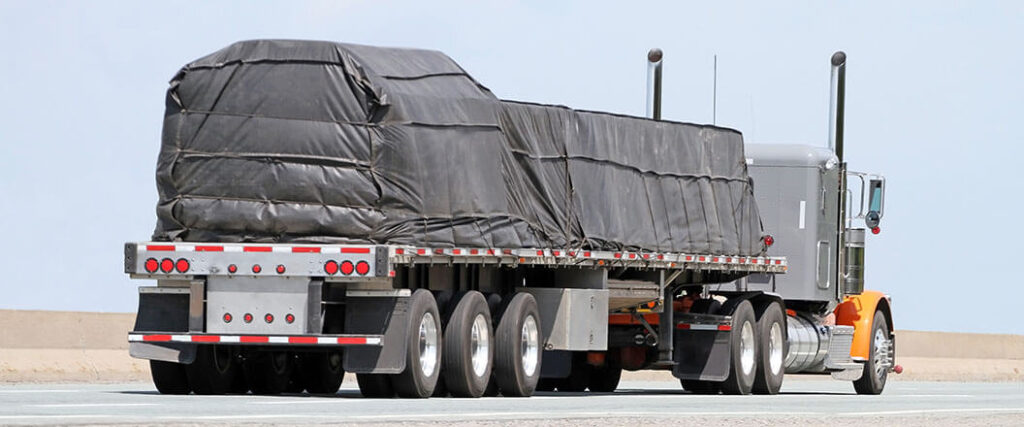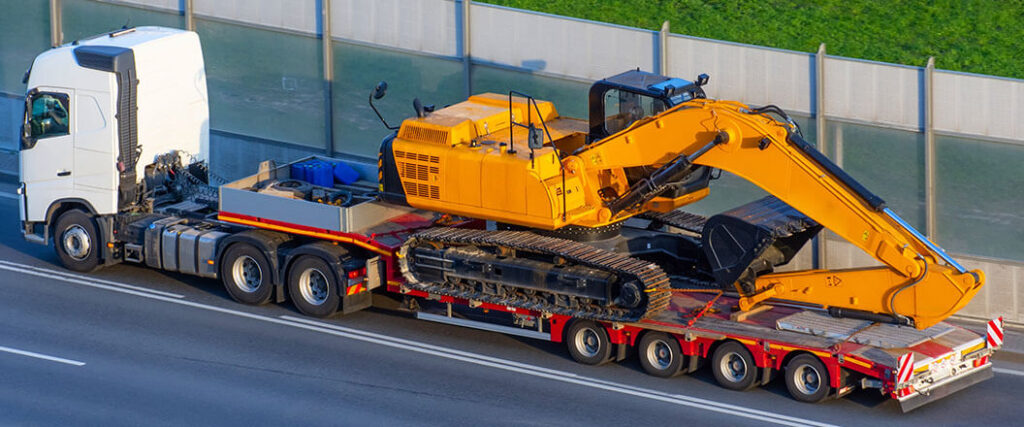Flatbed shipping rates vary from company to company. One thing that is certain is that large and bulk loads of freight can be very expensive. What many shippers don’t know is that they can negotiate their way to cheaper flatbed freight rates.
Flatbed shipping rates are dependent on the weight of the freight being shipped, distance, destination and fuel costs. The average shipping rate in the U.S. is $2.70 per mile, but can fluctuate by region. To find the best shipping rate, it's critical that you find a carrier that meets the individual needs of your business.
Flatbed shipping rates can be difficult to understand, which in turn makes negotiating cheaper ones more difficult. In this article, we will show you how rates are determined, as well as the different types of flatbed trailers that are used to transport loads.
The average flatbed shipping rate in the U.S. sits at just above or $2.73 per mile. However, in some regions of the U.S., these prices can differ by a few cents. In the table we provide the different flatbed rates in each region of the country.
| Region | Rates |
| West | $2.30 per mile |
| Midwest | $2.98 per mile |
| North | $2.71 per mile |
| Southeast | $2.83 per mile |
| Southwest | $2.69 per mile |
These rates will be factored in the total cost of your shipment. Keep in mind, these are the average rates by region. Flatbed shipping rates and the specific rate can vary by state and the carrier that you choose to use. You should also keep in mind that the average shipping rate can fluctuate due to current events and other factors
When you ship freight there are eight different types of shipping zones that your freight could travel. Each zone represents a certain amount of miles.
To calculate how much it will cost to ship a certain distance, you would simply multiply your specific rate by the amount of miles it will travel. The miles for shipping zone is as follows:
Shippers will need to know how far their freight will travel to accurately calculate their flatbed hauling rates.

Much of what determines flatbed shipping rates is the weight of the freight that is being shipped. Factors like fuel costs, destination and weight of the freight all have an impact on the expenses of flatbed shipping rates.
How much your freight weighs is a large factor that determines the flatbed shipping rates. The most common way that freight costs are calculated in the shipping industry is per hundredweight or (CWT).
Freight that weighs more requires specialized chassis and trailers in order to transport them, hence costs being higher for heavier types of freight. Flatbeds, for example, are typically used to transport heavier types of freight.
Heavier types of freight also burn more fuel to transport, requiring the driver to stop and refuel more often. Additionally, the price of fuel can affect current flatbed rates as well. Higher fuel rates will require carriers to raise rates in order to make up for what they will have to spend on fuel.

We fight for flatbed hauling rates that are fair to you. Get a personalized quote from our industry experts.
Flatbed trucking requires the transportation of extremely large pieces of freight. Because of this, certain routes might not be usable to reach a certain destination.
Driving on a highway often requires going under an overpass or through a bridge. Doing so while carrying freight that is too tall to fit under obstructions like those will require your carrier to find an alternate route.
Using an alternate route will increase your flatbed rate per mile. An alternate route that is more suitable to the dimensions of your shipment could be longer. A longer route will make flatbed rates per mile more expensive.
Flatbed load rates can also vary based on the final destination’s region. This means the amount it costs to ship goods within a region or from one to another can vary greatly.
Giving an exact amount to how much shipping flatbed freight should be is hard to do. However, we can show you how to calculate how much it will cost to ship using a flatbed.
The average distance that a truck travels when it transports freight is around 206 miles. Freight that is shipped this distance would travel down shipping zone 3.
We’ll show you what your flatbed freight shipment will cost if you ship the national average for shipping distance.
| Region | Shipping Cost |
| West | $607.70 |
| Midwest | $698.34 |
| North | $642.72 |
| Southeast | $657.14 |
| Southwest | $618.00 |
Flatbed trucking rates and miles will change based on the unique features of every shipment. If you don’t want to complete any calculations, then fill out one of our flatbed rate quote instead.
As a customer, you have every right to fight for flatbed hauling rates that are fair to you. With these methods at your disposal, you will be able to negotiate cheap flatbed shipping rates.
The main objective of every freight carrier is to fill their trucks with as much freight as possible. If you’re a shipper who sends bulk loads frequently, you can use that to your advantage when negotiating your current flatbed rate.
Shipping freight shouldn’t cost you more money than you make from selling the goods you’ve sold. Before you begin to look into flatbed shipping rates for your load, you should work out a budget that will help you find a flatbed trucking rate that you can afford.
You might come across carriers that have such high rates that even negotiating with them won’t be able to bring their costs down enough. Avoid carriers like these and find ones closer to your budget before you start negotiating flatbed load rates.
If you don’t bulk amounts of flatbed freight and only need a one-time shipment, then it’s important you pick an affordable spot rate. You can use a load board to compare spot rates for different shipping lanes to find one that is affordable for you.
The load to truck ratio takes how many loads there are and compares it to the available trucks that can transport those loads. Carriers that don’t have enough trucks to carry the loads that they have will tend to have higher flatbed hauling rates.
A good way to avoid these carriers is to look for carriers that have more available trucks and lower load requests to find flatbed rate quotes that are more affordable.
There might be additional fees on top of the flatbed load rates you will have to pay to get your freight moved. These fees could come in the form of toll roads or special permits to have your load transported. Some of these fees can be avoided by picking a good shipping route that won’t affect your current flatbed rate.
Negotiations on flatbed hauling rates are never final until you obtain a contract that officiates everything. Once you have reached an agreement with your carrier, be sure to get it down on paper. This will help guarantee the flatbed rate quote that you both agreed on.

There are many different types of flatbeds that are used to transport heavy freight. Each type of trailer is specialized to carry specific types of large and heavy freight.
The different flatbed types are:
Each trailer has unique advantages that make it perfect for transporting large loads of freight. The type of trailer that used can affect the flatbed freight rate a shipper has to pay.
The standard flatbed trailer is the most common one used in the shipping industry. Standard flatbeds are used to perform construction material transportation and other related services.
What makes standard flatbeds so great for carrying freight of this type is because of how easy it is to load. Freight can be loaded onto flatbeds from either direction except the front. Having multiple loading points makes loading large and longer types of freight easier.
The lowboy is a flatbed that is often used when extremely tall types of freight have to be shipped. Shipping requirements prevent freight from exceeding a certain height.
What makes lowboy trailers unique is that the bed is lower to the ground than the rear axle. Since the bed is lower to the ground, freight that sits up high is afforded some extra room below the height limit.

Reach out to us at (855) 490-2433 or fill out our quick form and a live agent will be in touch shortly.
Step deck trailers have a similar purpose as lowboy trailers. They allow for the transportation of taller goods that would normally surpass height limits if they were carried on a regular flatbed trailer. Step deck trailers are sometimes referred to as drop deck trailers.
Double drop deck extendable trailers have the benefits of a lowboy trailer with added length. This trailer is used to transport freight that would normally surpass height and length standards.
Additionally, the second rear deck of the trailer can be utilized as support for longer freight. This prevents freight from overhanging.
The removable gooseneck is versatile and comes with many customizable options. The front of the trailer that attaches to the truck is removable. The amount of axles that gooseneck can have is flexible. The trailer can have anywhere from three axles to 20 axles.
Removable gooseneck trailers are extremely easy to load equipment and freight on. The deck of the removable gooseneck can be lowered to the ground. This allows for an operator to drive vehicles onto the bed.

The conestoga is a flatbed trailer that comes with a tarp attached to it. The tarp can be extended and retracted. This simple addition makes wrapping freight with tarp much more convenient than it is.
Rather than carrying traditional flatbed freight like construction equipment, the conestoga trailer is usually used to transport heavy freight that needs added protection during transit. This could include freight like helicopters and robotics.
Side kit trailers are similar in appearance to dry vans. The bed of the trailer has panels going all around it. The side kit is used to transport goods like corn, coal or other types of goods that are broken up into small bits. They can also transport heavier types of freight that don’t require crating services.
Another feature of the side kit trailer are the metal bars that arch over the bed and attach to the top of the left and right panels. Tarps can be placed on top of these metal bars and are secured on each side of the panels.
If you need a flatbed trailer to ship your freight, then look no further than Heavy Haul and Oversized to help you out. There are numerous carriers that we conduct business with that can get your flatbed load to its destination.
Whether you need to move construction equipment, a helicopter or a whole flatbed of corn, we can find the perfect carrier for you while offering an affordable flatbed freight rate.
Our carriers can use the following trailer to move your freight:
Give us a call at (855) 490-2433 or you can fill out your free Heavy Haul and Oversized flatbed rate quote and be one step closer to finally getting your freight shipped.
Heavy Haul and Oversized
315 NE 14th Street #4122
Ocala, FL 34470